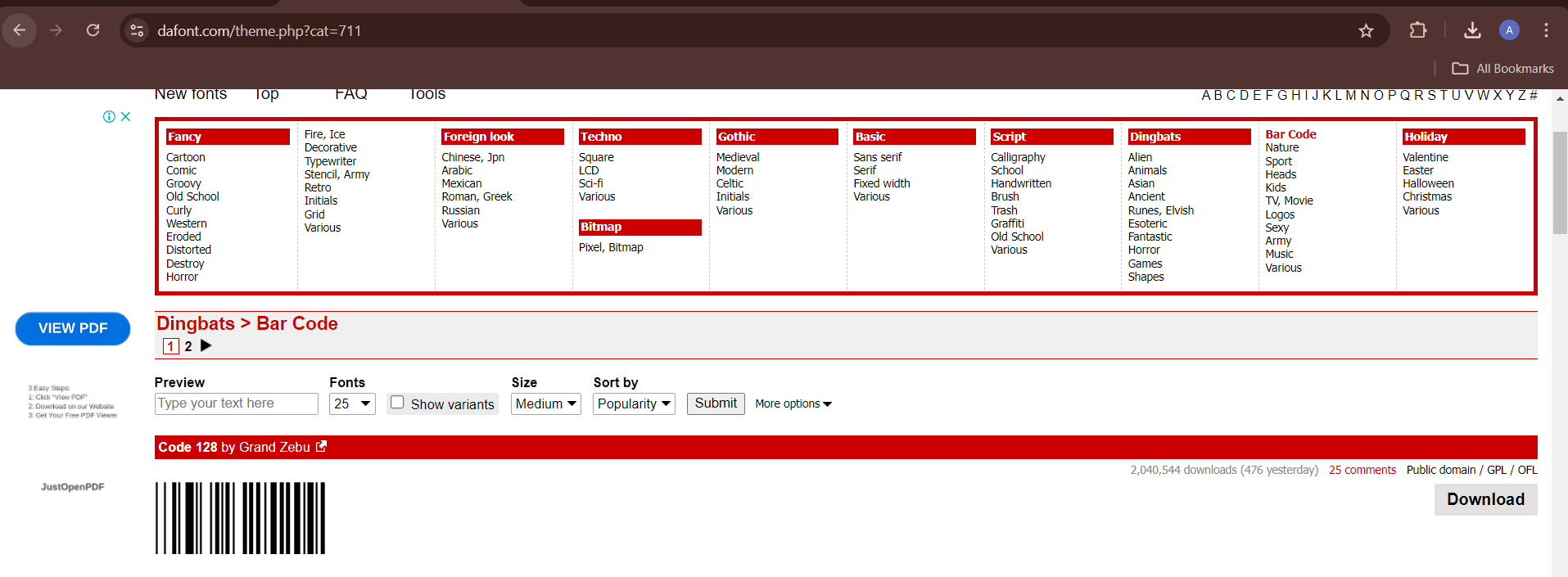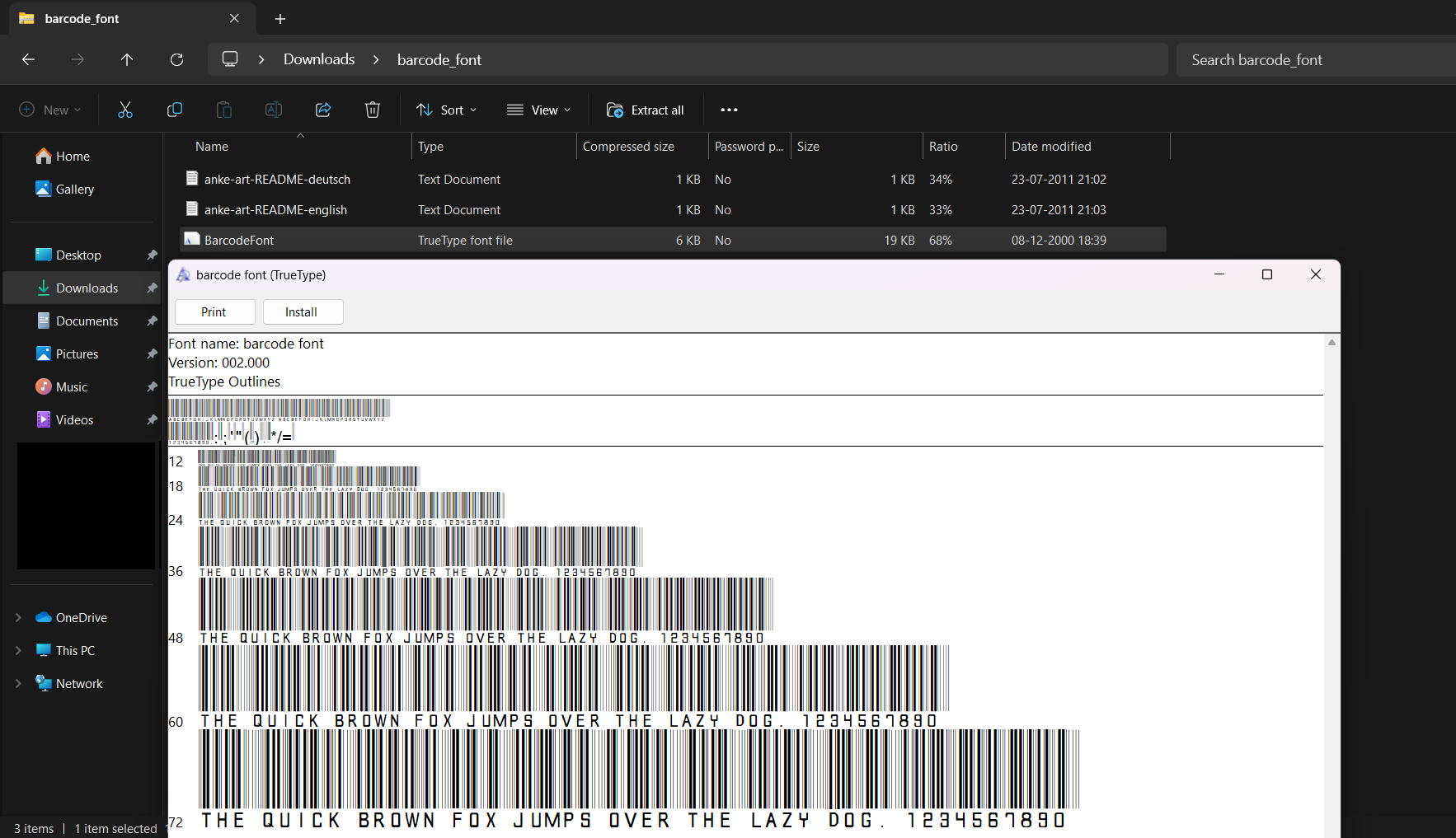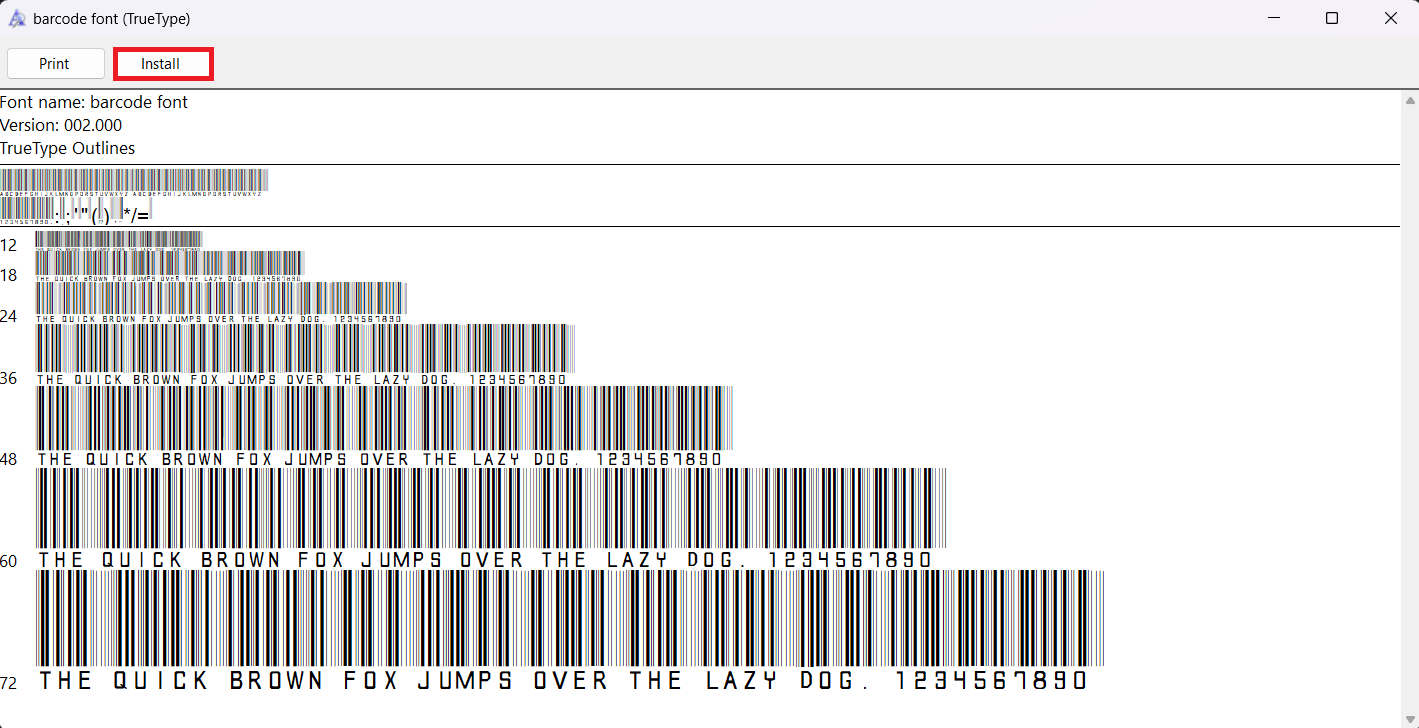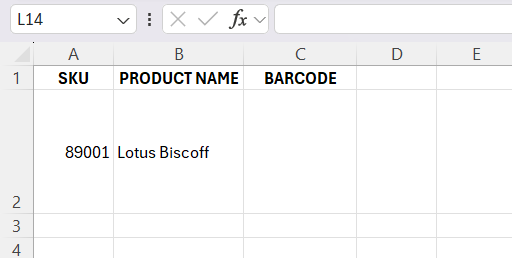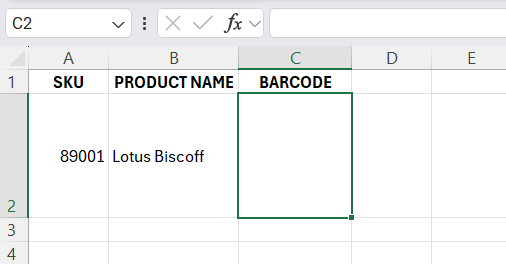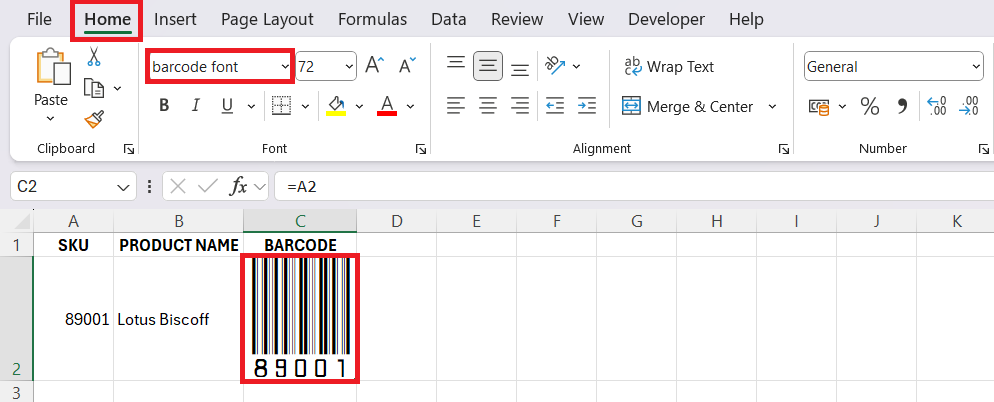Incorporating barcodes into Excel can be a game-changer for tracking and managing data. Barcodes make it easy to scan information directly into systems, eliminating data entry errors and speeding up workflows. In this guide, I’ll walk you through how to add barcode fonts in Excel so you can generate barcodes right from your spreadsheets.
Key Takeaways:
- Barcodes in Excel streamline data management, reducing errors and speeding up workflows.
- Choose the right barcode font for your needs; Code 39 is a versatile option.
- Ensure the barcode font is compatible with your Excel version to avoid issues.
- Proper formatting, including quiet zones and clear visibility, ensures reliable scanning.
- Barcodes have diverse applications—from inventory to marketing—making Excel a powerful tool for integration.
Embark on the Barcode Journey
Decoding Barcode Usage in Excel
Barcodes have become an integral part of modern inventory management, and integrating them into Excel has streamlined numerous business processes. As we dive into the role of barcodes within Excel, it’s clear that they offer an efficient way to store and track information.
From product labeling to encoding complex data for easy retrieval, barcodes in Excel allow for quick data entry, avoidance of human errors, and seamless scanning capability which facilitates inventory control, asset tracking, and the swift processing of sales transactions.
Navigating the Types of Barcodes Suitable for Excel
When looking at barcodes that meld seamlessly with Excel, there’s a wide array from which to choose. Depending on your needs, you can select from linear barcodes like Code 39 and Code 128, which are perfect for general purposes. Then there are UPC/EAN barcodes, commonly used in retail to represent product numbers. For those handling logistics, I2of5 (Interleaved 2 of 5) is a staple for packaging and shipping.
Venturing into 2D barcodes, the QR code stands out as a versatile option, storing URLs, contact info, or other data that can be easily accessed with a smartphone. Other 2D codes like PDF-417 and Data Matrix are ideal for encoding large amounts of data in a compact space. With Excel, the creation of these barcodes is streamlined, making the transition from data cell to scannable code almost effortless.
Table of Contents
Preparing Your Toolkit
Acquiring the Right Barcode Font
To successfully embark on your barcode integration in Excel, you’ll need to acquire the right barcode font. One highly recommended and widely recognized font is the 3 of 9 Barcode TrueType, or Code 39. It strikes the perfect balance of versatility and ease of use for businesses and educational purposes. When selecting this font or others, consider your specific application needs—whether you’re tracking inventory, managing assets, or simply organizing data.
Keep in mind that while some barcode fonts are available for free, they may be limited to non-commercial uses. If commercial use is in your plans, you might need to invest in a licensed version. Also, ensure that the barcode font you choose is compatible with your systems and supports the characters or data you plan to encode. Investing a bit of time in selecting the right font will save a lot of potential headaches down the line.
Ensuring Excel Compatibility
Before installing a new barcode font, confirming that it’s compatible with your version of Excel is crucial. Whether you’re using Excel 2007, 2010, 2013, 2016, or even the latest Excel 365, compatibility ensures that once the font is installed, it will work seamlessly within your spreadsheets.
Most popular barcode fonts are designed to work well with a range of Excel versions. However, it’s essential to read the font specifications or contact the supplier to make sure there won’t be any compatibility issues. Remember to check if the barcode font supports both your Excel version and your operating system, whether you’re working on Windows or Mac OSX. Compatibility concerns are especially pertinent if you plan to distribute Excel sheets embedded with barcodes, as you want to ensure the barcodes stay intact and scannable no matter where the spreadsheet goes.
Step-by-Step Installation Adventure
Finding and Downloading Barcode Fonts
To begin your search for the perfect barcode font, there are reputable online resources. While each website may provide slightly different font options or versions, Code 39 is a consistent performer that has proven effective in my research, and it’s recommended for Excel users.
Once you navigate to one of these websites, look for the barcode font that best fits your needs—bearing in mind the free versions are often for educational or personal use only. The process typically involves the click of a download button, and shortly after, the font file should be available on your system, ready to be installed.
An important note is to ensure the font’s compatibility with your system and Excel version before downloading. I’ll guide you on how to install these in the next section, so let’s proceed with your barcode venture.
Easy Guide to Install Barcode Fonts in Excel
Installing barcode fonts in Excel is a straightforward process once you’ve downloaded the right font file. Here’s how you can make it a smooth ride:
STEP 1: Open the folder where you’ve saved the downloaded font file. It will usually be a .zip archive, which you need to extract using your system’s file extraction utility.
STEP 2: Double-click the extracted font file — it will typically have a .ttf or .otf extension. A preview of the barcode font will pop up.
STEP 3: There should be an “Install” button on the top-left corner of the preview window. Click it to install the font on your system. Admin rights may be required.
Now, there are a couple of important notes to keep in mind:
- After the installation, you might need to restart Excel to make the newly installed font available in your font list.
- Some barcode fonts may present compatibility issues with certain operating systems or Excel versions. If that’s the case, don’t hesitate to uninstall the troublesome font and try another option.
Once the font appears in your Excel font list, you’re ready to convert data into barcodes using this new typography. Ensuring ease and convenience in generating scannable codes right within your spreadsheets.
From Blank Cells to Scannable Codes
Transforming Data into Barcodes
After the installation hoopla, turning Excel data into barcodes is practically a cakewalk. Select the cell or range of cells that contains the data you want to encode. Then, switch the font to the barcode font you installed from the Home tab in Excel.
However, keep in mind that some barcode formats require specific syntax—often an asterisk (*) before and after data to signify the start and end of the barcode. Once formatted correctly, your alphanumeric data transforms into a series of stripes ready for scanning.
Here’s a quick guide for the transformation:
STEP 1: Enter the data you want to encode in a cell.
STEP 2: Highlight or select the cell where the normal font data needs to be converted to a Barcode.
STEP 3: Choose the barcode font from the font dropdown in the Home tab.
Voilà! Your data is now a scannable barcode. Just ensure the cells are sized appropriately so that the entire barcode is visible — none of the barcode lines should be squished or extended.
Formatting Tips for Optimal Barcode Generation
For generating effective barcodes in Excel, proper formatting isn’t just a recommendation; it’s a necessity. Here are my golden rules to follow:
- Ensure enough white space around your barcode; this is known as the quiet zone and is crucial for scanners to recognize where the barcode begins and ends.
- Adjust column width and row height to make sure the entire barcode is displayed without any clipping. A good practice is to print a test page to confirm the barcode scans correctly.
- Choose a cell format that prevents Excel from automatically changing your data, such as formatting numbers with leading zeroes as text.
- If your barcode font allows, add human-readable text below the barcode by utilizing font options that include text or by creating a separate row underneath your barcode for descriptions.
- When printing, utilize high-resolution settings and ensure your printer doesn’t stretch or shrink the barcode, which might render it unreadable.
By adhering to these formatting nuances, you ensure your barcodes are not only accurate but also scannable under various conditions.
Making the Most of Your Barcode Endeavor
Creative Uses of Barcodes in Excel
Barcodes in Excel aren’t confined to just inventory and retail—they’re a tool of infinite potential. For example, educational sectors utilize them for tracking books and resources in libraries or managing equipment in classrooms. Event organizers can leverage barcodes for efficient check-ins, badge control, or to swiftly share information with attendees via scan-able codes on programs or posters.
In addition, if you dabble in creative marketing, barcodes can be your secret weapon. You could embed URLs into QR codes within product catalogs, driving customers to web pages, promotional videos, or exclusive online content. Real estate agents might even list property details that potential buyers can scan during showings.
With Excel’s versatility in handling data, coupled with the ability to generate custom barcodes, these novel applications are only scratching the surface.
Advantages of Having a Barcode System
Incorporating a barcode system into Excel is like adding superpowers to inventory management and data tracking. Here are a handful of benefits:
- Speed and Efficiency: Scanning barcodes is far quicker than manual data entry, dramatically speeding up transactions and information processing.
- Accuracy: Human error is significantly reduced with barcodes, ensuring reliable data for inventory, sales, and other critical business operations.
- Cost-Effectiveness: Implementing a barcode system in Excel is remarkably cost-efficient, especially considering the savings from reduced errors and time.
- Real-Time Data: As items are scanned, real-time updates provide an accurate view of inventory levels, reducing the risk of stock-outs or overstock.
- Versatility: Barcode systems can be customized to suit various business needs, from tracking assets and managing event attendance to facilitating point-of-sale operations.
With solid advantages like these, the decision to integrate a barcode system into Excel seems not just practical, but almost imperative for businesses looking to streamline their processes.
FAQ: Answering Your Barcode Queries
What versions of Excel can make barcodes?
Microsoft Excel versions 2007, 2010, 2013, and 2016 all support barcode creation natively or with the help of add-ins like OnBarcode Excel Barcode Generator. The latest offering, Excel 365, is also equipped for this task, ensuring users on both older and cutting-edge versions can leverage barcode technology.
What is the simplest way to add barcode fonts to Excel?
The simplest way to add barcode fonts to Excel involves downloading a desired barcode font, installing it on your system, and then applying it to your data in Excel by changing the font style. This process is generally straightforward and user-friendly, making barcode generation in Excel accessible even for those without extensive technical expertise.
Can I create barcodes in Excel without third-party software?
Yes, you can create basic barcodes in Excel without third-party software by using barcode fonts like Code 39 or Code 128. After installing the barcode font, you can input your data and format it with the new font to create simple barcodes directly in Excel. However, for more complex barcode requirements, an add-in might be necessary.
How do I troubleshoot if my barcode isn’t scanning?
If your barcode isn’t scanning, check the size and confirm there’s a clear quiet zone around it. Make sure the data is correctly formatted with any required start and stop characters. Test print on high-quality settings to avoid blurry or smudged barcodes, and always use a scanner to test printouts before mass printing.
What’s the deal with code 39?
Code 39 is a popular alphanumeric barcode type frequently utilized for various labeling purposes. It stands out because it’s easy to print, widely supported by barcode scanners, and does not require a checksum. It can encode 43 characters including letters, numbers, and a few special symbols. Its versatility makes it a go-to choice for many industries.
John Michaloudis is a former accountant and finance analyst at General Electric, a Microsoft MVP since 2020, an Amazon #1 bestselling author of 4 Microsoft Excel books and teacher of Microsoft Excel & Office over at his flagship MyExcelOnline Academy Online Course.

